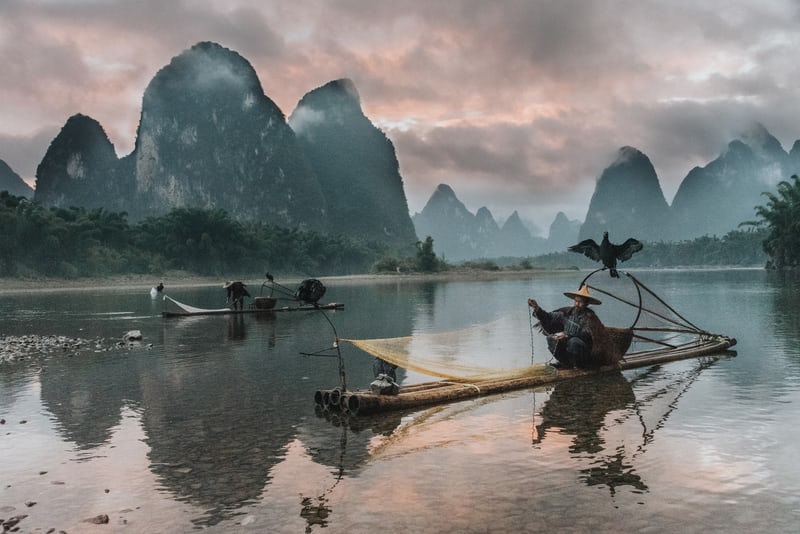

Combine Your Passions to Create Something New
How My “Novel in Settings” Meshed Travel Writing with Fiction
By Eric D. Goodman
During a recent interview related to the publication of my new adventure thriller, The Color of Jadeite, I was asked what motivated me to write this novel. The question made me pause, in part, because most of my past work falls into the “literary fiction” category, making my latest a departure (or arrival) of sorts, from literary to genre fiction.
Normally, my response to the “where do you get your ideas” question is simple enough: the seed of a story, for me, almost always begins with either a character, a pictured scene (usually of dialogue), or an interesting idea.
For example, an earlier novel centered around the release of a private reserve of exotic animals into a community and how that event unfolded from a variety of perspectives. In that case, what inspired me was the idea of how a news story exists differently for different people.
Another novel was told from the point of view of a fetus, an idea born from my drive to come up with the most unusual narrator I could conjure.
But for The Color of Jadeite, I found myself describing it (unofficially) during the interview as a “novel in settings.”
![]()
I’ve written a “novel in stories” and a “novel in utero”, but a “novel in settings”, I realized during that interview, was something new—and probably something right up my ally.
Setting has always been important to me. One critic described the city of Baltimore in my novel in stories, Tracks, as a sort of character in itself. But I normally start with the idea or the characters and everything expands from that center. It was different for Jadeite.
I should mention that in addition to writing fiction and articles about fiction writing, I’m a travel writer. My enthusiasm for travel is second only to my passion for writing, and I try to take at least two or three international excursions a year.
Most of my travels take me to western and eastern Europe, from Portugal to Russia, Sweden to Italy, and anywhere in between. Aside from our home in the United States, Europe is where I feel I most belong.
However, we recently spent two weeks exploring China, and I was mesmerized by the sights. Our travels took us from Beijing to Xi’an, Shanghai to Hangzhou and Suzhou.

As we explored Tiananmen Square and the Forbidden City, examined the terracotta warriors and Jada Buddha Temple, cruised by canal to Suzhou’s ancient food market and wandered the Lingering Garden, I found myself repeatedly thinking “this would make a great setting for a novel.”
Such thoughts aren’t new to me. I can remember as far back as high school, living in Japan and taking notes about parks and houses and shopping arcades, imagining these descriptions as helpful in the pre-Internet, pre-hundreds-of-digital-pictures era.
In college, when studying in Russia, I remember taking notes in finite detail about the classroom’s floor, the desks, the wallpaper, what the professors and students wore when I should have been taking lecture notes. I would revisit these notes months and years later when I wanted to describe a unique place in a story.
And certainly, I’ve taken pictures and notes of unusual settings many times before, wanting to accurately describe them in travel stories or fiction later.
These days, the ease and abundance of digital photography fills in a lot of the blanks allowing for less wordy notetaking, but it’s important to capture the mood and feel, the smells and sounds, the emotion of a setting.

In travel writing, to portray the full picture better than a picture can. In fiction, to have more information to use or manipulate, to craft into a realistic scene.
I’ve been writing fiction all of my life, since an elementary school assignment turned me onto the craft thirty-some years ago. I came to travel writing later, in my early 30s. Although my history with fiction is much longer, I didn’t secure a NYC literary agent until my late 30s and saw the publication of my first novel at 40.
Although both travel writing and fiction—and even using locales from my travels in my novels—have been regular, ongoing parts of my career, it wasn’t until this trip and this novel that I consciously combined my enthusiasm for travel and travel writing with my zeal for fiction writing.
This is, perhaps, in part because much of my fiction is focused on dialogue and drama, the people and their situations, and it’s natural for me to place them in places close to home—where I’ve lived, where I know best.
A globe-trotting adventure thriller is a different sort of writing.
And as I toured China, savored the Temple of Heaven, relaxed over lunch in the Hutong, and thrilled at the scooter-rickshaw ride between tight cars in heavy traffic, the thought kept reoccurring: this isn’t just a great idea for setting a novel—these are ideal locations for scenes of a thriller. I could see Sam Shepherd, Robert Langdon, Sam Spade, Indiana Jones, Mike Hammer, or Cotton Malone running through or searching these places for clues or MacGuffins.

I found myself plotting out reasons for a character to be in this place or that. A stone tablet in a temple, a miniature jade statue in the hand of a large one, a chase through the busy, lit-up streets of urban Shanghai, an inscribed shard of terracotta from a warrior’s hem.
Scenes of dialogue between characters began to form in my evening notes, interesting clues steeped in Chinese culture and history, and for the first time I was working on developing an outline for a novel while still exploring the place both for pleasure and for travel stories.
The Color of Jadeite is classified as a “literary thriller,” an adventure that takes the main characters, their sidekicks, and their rivals across China in pursuit of a jadeite tablet from the Ming dynasty.
I had my locations, my characters, and a plotted timeline for getting them from one place to another. I needed a reason for my characters to be romping across China.
What began as a MacGuffin—the jadeite tablet—soon became pivotal to the story, not only because this jadeite tablet that once belonged to Emperor Xuande was something everyone was after, but because it held a deep and personal connection with more than one of the characters. Poetry and treasure and history and legacy all romancing one jadeite artifact.
As normally happens, everything seemed to form, through the notes and the writing, organically, as though it was already there and I was simply discovering it. This novel, for me, went to show that the process can change and still bear fruit.

More importantly, it revealed that writing travel stories or an occasional short story isn’t the only way to make use of unique and interesting places I’ve traveled. It is not only possible, but enjoyable, to combine your seemingly unrelated passions into one.
For me, combining my exploration through China with my adventures in writing was an exciting journey in itself, and I’m gratified by the end result.
What’s interesting is that, as different as this novel is in style and plot from my other novels, my semi-conscious intention seems to be the same at heart: to bring people together and to promote understanding and compassion.
For such fiction, the idea or character normally initiates that wish—but for this novel, it came out of an appreciation for the places I was experiencing and a desire to bring these settings, feelings, the overall experience of Chinese culture and history, to an audience that may not be familiar with it.
Many, if not most, readers will likely come away with the feeling of having read an exciting adventure thriller, and that is enough.
But underneath that surface layer, in the dialog and background, the history and culture of China is interwoven into the novel. It’s great when you can learn something unexpected while reading a novel for pleasure.

For me, it was a combination of travel and fiction. What will it be for you? A love of gardening could find its way into the center of a spy novel in which the hobby gardener is brought into the center of a plot against America.
A passion for wine could take a young winemaker to the vineyards of France or Italy in a new romance novel. A cigar aficionado could make cigars central to a smuggling operation for a crime novel.
A flair for finance could be invaluable to a novelist working on a drama about cybersecurity or a hacking of Wall Street.
It doesn’t have to be fiction, either. Just because you’re stuck in a job doing technical writing, advertising copy, or public affairs press releases doesn’t mean you can’t write about your own passions—family, cars, model airplanes, the ingenious strategy for getting the best streaming movies and television.
Test the waters with an article, then see if you have the desire to write a nonfiction book on the subject.
Whatever your passion, whatever your writing category, combining your interests with your writing in new ways provides an opportunity to combine your passions and create something new and interesting.

 Eric D. Goodman is a full-time writer who lives in Maryland with his wife, son, daughter, and family dog. His most recent novel is the literary thriller, THE COLOR OF JADEITE (Apprentice House Press, October 2020). He is author of SETTING THE FAMILY FREE (Apprentice House, 2019), WOMB: A NOVEL IN UTERO, (Merge Publishing, 2017), TRACKS: A NOVEL IN STORIES, (Atticus Books, 2011) and FLIGHTLESS GOOSE, a storybook for children (Writer’s Lair Books, 2008).
Eric D. Goodman is a full-time writer who lives in Maryland with his wife, son, daughter, and family dog. His most recent novel is the literary thriller, THE COLOR OF JADEITE (Apprentice House Press, October 2020). He is author of SETTING THE FAMILY FREE (Apprentice House, 2019), WOMB: A NOVEL IN UTERO, (Merge Publishing, 2017), TRACKS: A NOVEL IN STORIES, (Atticus Books, 2011) and FLIGHTLESS GOOSE, a storybook for children (Writer’s Lair Books, 2008).
More than a hundred of his short stories, travel stories, and articles about writing have been published in literary journals and periodicals. When he’s not writing, Eric loves traveling, and most of the settings in THE COLOR OF JADEITE are places he has visited. Founder and curator of Baltimore’s popular Lit and Art Reading Series, Eric can be found at www.Facebook.com/EricDGoodman, www.Twitter.com/Edgewrite, and www.EricDGoodman.com.
Learn more about THE COLOR OF JADEITE at www.EricDGoodman.com/Jadeite.html or order your copy at www.amazon.com/Color-Jadeite-Eric-D-Goodman/dp/1627202862.
We’d love to hear from you in the comments! How do you use “setting” to create deeper, richer, more believable stories? Let us know in the comments!











